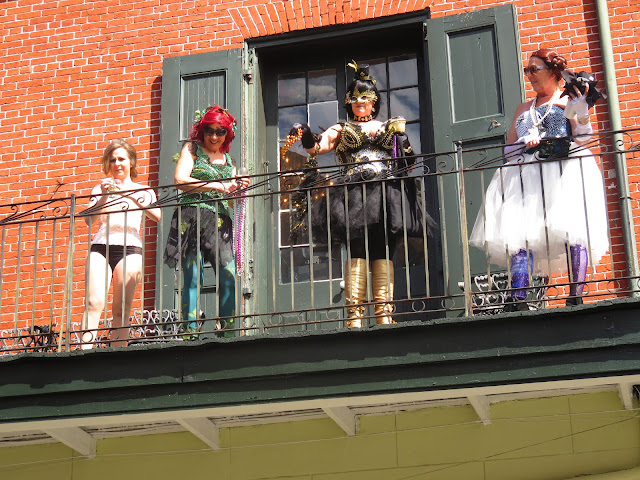The cultural heritage of New Orleans includes the Second Line parade. When clubs, small groups or organizations get together for any kind of celebration it usually includes a Second Line. Weddings and funerals are common venues for a Second Line. My first exposure to the whole Second Line Parade culture was the James Bond film "Live and Let Die" in 1973 which featured a funeral Second Line somberly marching down Dumaine St in the French Quarter. The lead brass band was followed by a coffin and then a group of people with parasols and handkerchiefs. At a trumpet cue the somber group breaks out into marching and dancing. All this happened 2 minutes into the film and left me wanting more.
Fast forward 44 years later and we had our own Second Line marching through the French Quarter. It was a long time coming, but I was going to be part of a New Orleans Second Line Parade. With parade permit in hand, a police escort, 36 willing dancers from North Carolina and an 8 piece brass band, the "Third Line", we were ready.
The Cast of Characters
"We are the parade today"
.
Libbie painted and beaded up
The BOT crew assembling
Ladies instructional meeting
Sharon going over the details
Libbie and Anne ready to go
Our Mardi Gras Leaders and New Orleans natives, now Raleigh residents,
Darryl and Sharon
Some of the BOT ladies
When all were assembled the band began playing our Second Line marching songs and practice commenced. During practice our Second Line New Orleans Police Department escort arrived. We were honored to have a uniformed motorcycle office leading the parade with flashing blue lights and a New Orleans squad car following the parade, also with Blue Lights flashing.
After a little practice on the sidewalk it was showtime. We marched down the street with band playing, parasols twirling and handkerchiefs waving, dancing to the tunes of our own brass band.
We went to the first of 3 bar stops in New Orleans Second Line tradition. Our first stop was the "Chart Room" on the corner of Chartres and Bienville in the French Quarter.
Our first stop for Bloody Mary's at 9:30 AM
Our band hydrates at the Chart Room
New Orleans PD patiently wait for the parade to resume
Group pic - The Second Line Dancers and 3rd Line Band
"Cocktails to Go"
Some of our BOT Krew enjoying beverages outside of Cafe Pontalba
Outside the Cafe Pontalba on Jackson Square the band hydrates again
Blaise and Kathy practicing & resting outside Cafe Pontalba
Marching under the Mardi Gras Bead Trees on Jackson Square
Our next parade segment - on to "Tu Jagues" for more refreshments
From the Balcony of Tu Jagues, ladies tossed beads
Our band entertained on the street outside of Tu Jagues
After Tu Jagues, it was time to march on! Our final stop and the end of the parade was lunch at Jackson Brewery.
Food and Brew time for Anne
From our table upstairs in the brewery we can see riverboats going by on the Mississippi

Natchez docks outside the Jackson Brewery at the Toulouse Street Wharf
A tradition on Mississippi River steamboats since the 1800s is the Steam Calliope. In the early days of river boating, a shrieking whistle signaled the arrival or departure of a Steamboat. In 1855 inventor Joshua C. Stoddard assembled a grouping of steam whistles controlled by a keyboard mechanism. He named his invention a Calliope. It wasn't long before the Steamboats adopted his invention as accompaniment on their river journeys, entertaining both passengers and passersby on shore. These Steam Calliopes had anywhere between 25 and 67 pipes. Today there are only 4 Steam Calliopes left on boats operating on the Mississippi. The Natchez has a Steam Calliope with 32 notes.
We were delighted that good fortune had us in the vicinity of the Natchez when the Calliope was operated.
We were delighted that good fortune had us in the vicinity of the Natchez when the Calliope was operated.






















